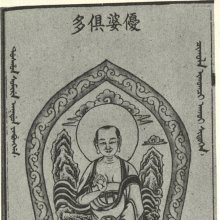Upagupta: 12 definitions
Introduction:
Upagupta means something in Buddhism, Pali, Hinduism, Sanskrit. If you want to know the exact meaning, history, etymology or English translation of this term then check out the descriptions on this page. Add your comment or reference to a book if you want to contribute to this summary article.
Images (photo gallery)
In Hinduism
Purana and Itihasa (epic history)
Source: Wisdom Library: Bhagavata PuranaUpagupta (उपगुप्त):—Son of Upaguru (son of Satyaratha). He was a partial expansion of the fire-god (Agni). He had a son named Vasvananta. (see Bhāgavata Purāṇa 9.13.24-25)
Source: archive.org: Puranic EncyclopediaUpagupta (उपगुप्त).—A King of the Candravaṃśa (Lunar dynasty). (See under Genealogy).
Source: Cologne Digital Sanskrit Dictionaries: The Purana IndexUpagupta (उपगुप्त).—The son of Upaguru and an aṃśa of Agni. Father of Vasvananta.*
- * Bhāgavata-purāṇa IX. 13. 24-5.

The Purana (पुराण, purāṇas) refers to Sanskrit literature preserving ancient India’s vast cultural history, including historical legends, religious ceremonies, various arts and sciences. The eighteen mahapuranas total over 400,000 shlokas (metrical couplets) and date to at least several centuries BCE.
In Buddhism
Mahayana (major branch of Buddhism)
Source: Wisdom Library: Maha Prajnaparamita SastraUpagupta (उपगुप्त) is the name of a Bhikṣu according to the 2nd century Mahāprajñāpāramitāśāstra (chapter XV). Accordingly, “five hundred years after the Buddha’s parinirvāṇa, there was a Bhikṣu called Yeou po kiu (Upagupta); he was an Arhat with the six abhijñās; at that time he was the great teacher of Jambudvīpa. At that time, there was a one hundred and twenty year-old Bhikṣuṇī who had seen the Buddha when she was young. One day Upagupta went to her cell to ask her about the behavior of the Buddha when he was visiting”.
Note: The Buddha foretold to Ānanda the birth of Upagupta five hundred years after the parinirvāṇa. The Mahāprajñāpāramitāśāstra has Upagupta as a patriarch (Ācārya), calling him the great teacher of Jambudvīpa. However, Upagupta appears in the list of the patriarchs only in the Sarvāstivādin sources.

Mahayana (महायान, mahāyāna) is a major branch of Buddhism focusing on the path of a Bodhisattva (spiritual aspirants/ enlightened beings). Extant literature is vast and primarely composed in the Sanskrit language. There are many sūtras of which some of the earliest are the various Prajñāpāramitā sūtras.
General definition (in Buddhism)
Source: academia.edu: The Chronological History of BuddhismArya Sanavasika and Upagupta II (1470-1390 BCE) were the junior contemporaries of Madhyandina. Mahendra, the son of Sudhanu became the King. Chamasa, the son of Mahendra, succeeded him.
Source: WikiPedia: BuddhismUpagupta (c. 3rd Century BC) was a Buddhist monk. According to some stories in the Sanskrit text Ashokavadana, he was the spiritual teacher of the Mauryan emperor Ashoka. Upagupta’s teacher was Sanavasi who was a disciple of Ānanda, the Buddha’s attendant.
Languages of India and abroad
Sanskrit dictionary
Source: DDSA: The practical Sanskrit-English dictionaryUpagupta (उपगुप्त).—a. Hidden, concealed; °वित्त (vitta) whose wealth is concealed.
Source: Cologne Digital Sanskrit Dictionaries: Edgerton Buddhist Hybrid Sanskrit DictionaryUpagupta (उपगुप्त).—name of an alakṣaṇaka (q.v.) Buddha: Divyāvadāna 348.24 ff.; converts Māra, 357.3 ff.; 385.7 ff.; 428.4; Avadāna-śataka ii.203.1 (here called Sthavira-Upa°) ff.; Mūla-Sarvāstivāda-Vinaya i.4.2 ff.; see next.
Source: Cologne Digital Sanskrit Dictionaries: Monier-Williams Sanskrit-English Dictionary1) Upagupta (उपगुप्त):—[=upa-gupta] [from upa-gup] mfn. hidden, concealed
2) [v.s. ...] m. Name of a king.
Source: Cologne Digital Sanskrit Dictionaries: Yates Sanskrit-English DictionaryUpagupta (उपगुप्त):—[upa-gupta] (ptaḥ-ptā-ptaṃ) p. Concealed.
[Sanskrit to German]
Sanskrit, also spelled संस्कृतम् (saṃskṛtam), is an ancient language of India commonly seen as the grandmother of the Indo-European language family (even English!). Closely allied with Prakrit and Pali, Sanskrit is more exhaustive in both grammar and terms and has the most extensive collection of literature in the world, greatly surpassing its sister-languages Greek and Latin.
See also (Relevant definitions)
Starts with: Upaguptaka, Upaguptavitta.
Full-text: Vasvananta, Upaguptavitta, Upaguru, Ashvagupta, Yuyudha, Dhitika, Mathura, Shanavasika, Samragayati, Samrageti, Vashra, Alakshanaka, Agnisambhava, Vedhas, Ajugubgup, Naukrama, Gupta, Gup, Mara.
Relevant text
Search found 19 books and stories containing Upagupta, Upa-gupta; (plurals include: Upaguptas, guptas). You can also click to the full overview containing English textual excerpts. Below are direct links for the most relevant articles:
Maha Prajnaparamita Sastra (by Gelongma Karma Migme Chödrön)
Appendix 5 - The legend of Upagupta < [Chapter XV - The Arrival of the Bodhisattvas of the Ten Directions]
Story of the lazy bhikṣu admonished by a demon < [Chapter XXVI - Exertion]
Act 9.6: Ratnākara approves of Samantaraśmi’s venture to the Sahā universe < [Chapter XV - The Arrival of the Bodhisattvas of the Ten Directions]
Buddhist records of the Western world (Xuanzang) (by Samuel Beal)
Chapter 7 - Country of Mo-t’u-lo (Mathura) < [Book IV - Fifteen Countries]
Chapter 15 - Country of Sin-tu (Sindh) < [Book XI - Twenty-three Countries]
Chapter 1 - Country of Mo-kie-t’o (Magadha), part 1 < [Book VIII and IX]
Blue Annals (deb-ther sngon-po) (by George N. Roerich)
Chapter 4 - Hierarchy of the teaching < [Book 1 - The beginning of the story of the Doctrine]
Puranic encyclopaedia (by Vettam Mani)
In Asoka’s Footsteps (by Nina Van Gorkom)
The Bhagavata Purana (by G. V. Tagare)
Chapter 13 - The Description of the Race of Nimi < [Book 9 - Ninth Skandha]
Related products
